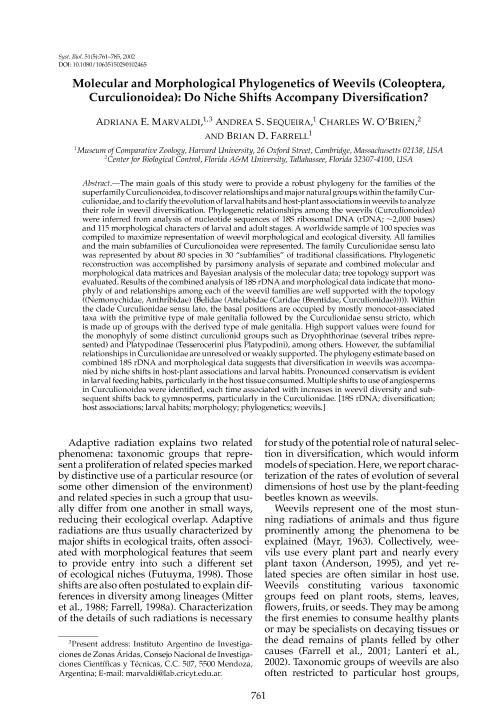Mostrar el registro sencillo del ítem
dc.contributor.author
Marvaldi, Adriana

dc.contributor.author
Sequeira, Andrea

dc.contributor.author
O'Brien, Charles W.
dc.contributor.author
Farrel, Brian D.
dc.date.available
2023-01-31T15:17:02Z
dc.date.issued
2002-12
dc.identifier.citation
Marvaldi, Adriana; Sequeira, Andrea; O'Brien, Charles W.; Farrel, Brian D.; Molecular and morphological phylogenetics of weevils (Coleoptera, Curculionoidea): Do niche shifts accompany diversification?; Oxford University Press; Systematic Biology; 51; 5; 12-2002; 761-785
dc.identifier.issn
1063-5157
dc.identifier.uri
http://hdl.handle.net/11336/186309
dc.description.abstract
The main goals of this study were to provide a robust phylogeny for the families of the superfamily Curculionoidea, to discover relationships and major natural groups within the family Curculionidae, and to clarify the evolution of larval habits and host-plant associations in weevils to analyze their role in weevil diversification. Phylogenetic relationships among the weevils (Curculionoidea) were inferred from analysis of nucleotide sequences of 18S ribosomal DNA (rDNA; ∼2,000 bases) and 115 morphological characters of larval and adult stages. A worldwide sample of 100 species was compiled to maximize representation of weevil morphological and ecological diversity. All families and the main subfamilies of Curculionoidea were represented. The family Curculionidae sensu lato was represented by about 80 species in 30 "subfamilies" of traditional classifications. Phylogenetic reconstruction was accomplished by parsimony analysis of separate and combined molecular and morphological data matrices and Bayesian analysis of the molecular data; tree topology support was evaluated. Results of the combined analysis of 18S rDNA and morphological data indicate that monophyly of and relationships among each of the weevil families are well supported with the topology ((Nemonychidae, Anthribidae) (Belidae (Attelabidae (Caridae (Brentidae, Curculionidae))))). Within the clade Curculionidae sensu lato, the basal positions are occupied by mostly monocot-associated taxa with the primitive type of male genitalia followed by the Curculionidae sensu stricto, which is made up of groups with the derived type of male genitalia. High support values were found for the monophyly of some distinct curculionid groups such as Dryophthorinae (several tribes represented) and Platypodinae (Tesserocerini plus Platypodini), among others. However, the subfamilial relationships in Curculionidae are unresolved or weakly supported. The phylogeny estimate based on combined 18S rDNA and morphological data suggests that diversification in weevils was accompanied by niche shifts in host-plant associations and larval habits. Pronounced conservatism is evident in larval feeding habits, particularly in the host tissue consumed. Multiple shifts to use of angiosperms in Curculionoidea were identified, each time associated with increases in weevil diversity and subsequent shifts back to gymnosperms, particularly in the Curculionidae.
dc.format
application/pdf
dc.language.iso
eng
dc.publisher
Oxford University Press

dc.rights
info:eu-repo/semantics/openAccess
dc.rights.uri
https://creativecommons.org/licenses/by-nc-sa/2.5/ar/
dc.subject
18S RDNA
dc.subject
DIVERSIFICATION
dc.subject
HOST ASSOCIATIONS
dc.subject
LARVAL HABITS
dc.subject
MORPHOLOGY
dc.subject
PHYLOGENETICS
dc.subject
WEEVILS
dc.subject.classification
Zoología, Ornitología, Entomología, Etología

dc.subject.classification
Ciencias Biológicas

dc.subject.classification
CIENCIAS NATURALES Y EXACTAS

dc.title
Molecular and morphological phylogenetics of weevils (Coleoptera, Curculionoidea): Do niche shifts accompany diversification?
dc.type
info:eu-repo/semantics/article
dc.type
info:ar-repo/semantics/artículo
dc.type
info:eu-repo/semantics/publishedVersion
dc.date.updated
2021-02-18T15:21:49Z
dc.journal.volume
51
dc.journal.number
5
dc.journal.pagination
761-785
dc.journal.pais
Reino Unido

dc.description.fil
Fil: Marvaldi, Adriana. Harvard University; Estados Unidos. Consejo Nacional de Investigaciones Científicas y Técnicas. Centro Científico Tecnológico Conicet - Mendoza. Instituto Argentino de Investigaciones de las Zonas Áridas. Provincia de Mendoza. Instituto Argentino de Investigaciones de las Zonas Áridas. Universidad Nacional de Cuyo. Instituto Argentino de Investigaciones de las Zonas Áridas; Argentina
dc.description.fil
Fil: Sequeira, Andrea. Harvard University; Estados Unidos
dc.description.fil
Fil: O'Brien, Charles W.. Texas A&M University; Estados Unidos
dc.description.fil
Fil: Farrel, Brian D.. Harvard University; Estados Unidos
dc.journal.title
Systematic Biology

dc.relation.alternativeid
info:eu-repo/semantics/altIdentifier/url/https://academic.oup.com/sysbio/article/51/5/761/1678476
dc.relation.alternativeid
info:eu-repo/semantics/altIdentifier/doi/http://dx.doi.org/10.1080/10635150290102465
Archivos asociados
